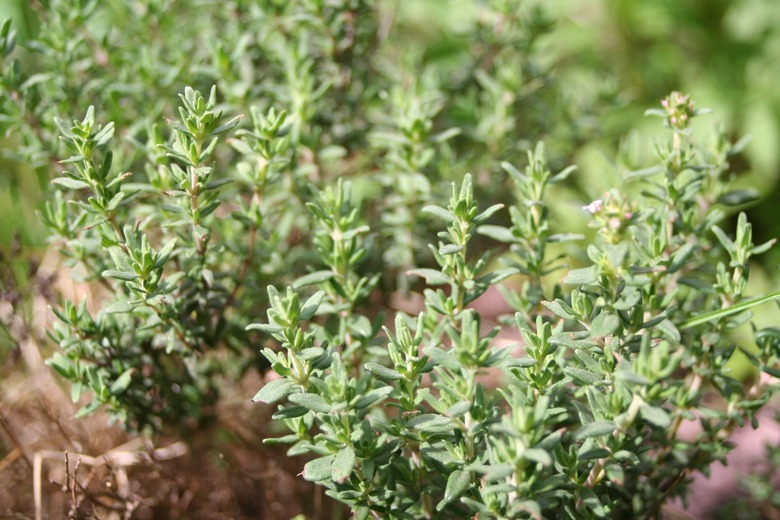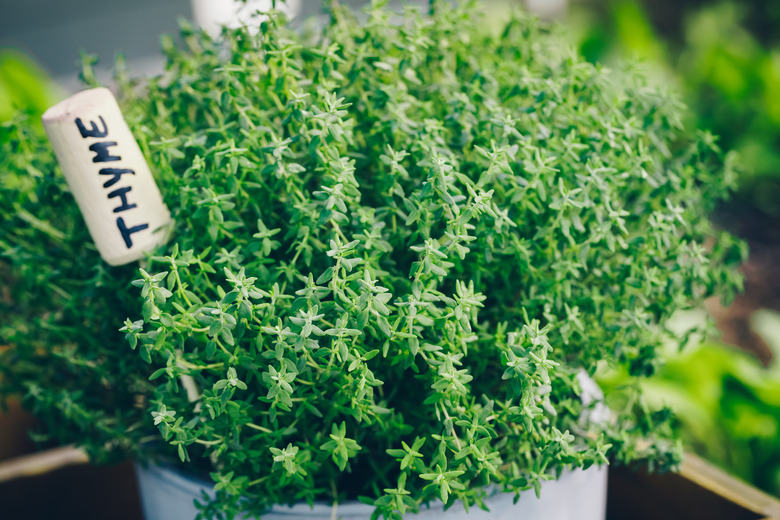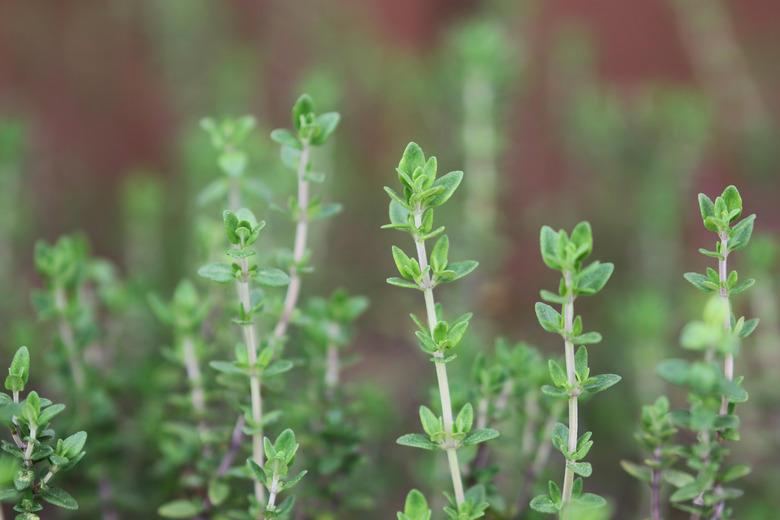How To Grow Common Thyme
We may receive a commission on purchases made from links.
Common thyme (Thymus vulgaris) is a fragrant herb often used in a variety of cuisines. Every cultivar of this attractive Mediterranean plant is edible. If you're thinking about a creeping thyme lawn, look for Thymus praecox or Thymus serpyllum; these are different species in the Thymus genus — they are edible but not very palatable. You can tell a common thyme plant by its woody stems and miniature leaves, but it's probably the scent that will ultimately tip you off.
Its Mediterranean origins mean thyme is highly tolerant of drought, so it's an excellent choice for water-starved gardens or forgetful gardeners. Pop some thyme in your herb garden to enjoy the fragrance and to entice bees and other pollinators to come for a visit.
Different cultivars of common thyme have different flower colors, but the most common shades are white, pink, and lavender. Most common thyme cultivars have a compact growth habit, but pruning is essential to maintain the plant's shape. Thyme provides much more than sprigs of fresh-tasting herb. It's a pretty plant that deserves just as much of a place in flower gardens as it does in kitchen herb containers.
Best Uses for Thyme
Best Uses for Thyme
You're probably aware that thyme is frequently used in culinary concoctions, and common thyme is the type most often used for cooking purposes. It's aromatic and adds a delightful, earthy flavor to soups, stews and roasts. But did you also know that thyme isn't just for cooking? It has a variety of uses in the garden and beyond.
Thyme is an excellent choice for gardeners in drought-prone areas because it does well on dry soils. It's great for rock gardens too. If you're searching for an easy-to-maintain ground cover, consider species of creeping thyme. As you walk on these plants, you'll get hints of the unmistakable thyme aroma.
Thyme will also gift you with pretty blooms during the summer. These blooms will attract plenty of beneficial insects to your garden. Some anecdotal wisdom says that burning thyme plants will ward off pesky insects. Thyme essential oil is also used for medicinal purposes and aromatherapy.
You can grow thyme in containers or on the ground. If you're growing thyme outside of its ideal growing zones, opt for containers so you can bring your plant in when the weather gets too cold.
Thyme doesn't grow very tall like other types of herbs, so it looks nice planted in the foreground of a garden or a container arrangement. Planting thyme in the middle of a garden bed, though, can help insulate the roots throughout the winter. You can also grow it with other herbs but choose its companions wisely. Herbs that need frequent watering aren't great pals for thyme.
How to Grow Thyme
How to Grow Thyme
Because it's difficult to grow thyme from seed, your best bet is to plant thyme seedlings purchased from a garden center or nursery. Plant the seedlings 12 to 24 inches apart in well-draining soil that's in full sun exposure. Expect your thyme plants to grow a maximum of 12 inches tall. You can also grow thyme from cuttings from a neighbor or on your own property.
In What Zone Does Thyme Grow Best?
In What Zone Does Thyme Grow Best?
You'll have the easiest time growing common thyme in USDA hardiness zones 5 to 9. There are over 100 varieties of thyme, though, so there's no guarantee that all of them will survive the winter in this entire zone range. Many low-growing species, like creeping thyme, are also quite hardy and can survive the harsh winters of zone 5 regions.
Tip
If you're interested in a variety that's not well-suited to your zone, opt to grow thyme in containers. You can bring plants inside for the winter and continue growing the perennial herb indoors.
When Should You Plant Thyme?
When Should You Plant Thyme?
Thyme likes it hot, so you need to wait until the soil has warmed in the early spring before transplanting it into the ground or putting it outside in a container. Wait until the soil reaches temperatures of at least 70 degrees Fahrenheit.
You can propagate cuttings indoors before the spring arrives, around six to 10 weeks before your last frost date, if you want your plant to get a head start on growth. Note that you can't take cuttings from dormant plants. You'll need to get a hold of cuttings from a nursery plant or houseplant.
Soil, Sunlight, and Water Recommendations for Thyme
Soil, Sunlight, and Water Recommendations for Thyme
Thyme is a lot less finicky than other Mediterranean herbs like basil, for instance, but that doesn't mean it's a walk in the park to grow. Thyme won't be happy unless it has sunlight. You'll need to pick a spot in your garden where your plant will get full sun for most of the day. If you're growing it indoors, a bright, sunny windowsill is a must if you want a healthy, thriving thyme plant.
The number one factor when considering soil type for thyme is to ensure it drains well. Waterlogged soil is the mortal enemy of drought-tolerant herbs like thyme. Keep your thyme plants away from garden areas with clay soils and never plant it in pots without drainage holes. Terra-cotta pots with drainage holes are ideal for plants that prefer dry soils.
Your thyme plant does need water, though, as long as it's not sitting in water for hours or days on end. Water deeply whenever you notice that the soil is completely dry. Are you not sure if your thyme plant needs watering? Stick your finger into the soil. Does it feel moist at all? Wait until the top few inches feel entirely dry and your thumb or index finger comes out dry as a bone before watering again. Thyme will tolerate a soil pH between 6.0 to 8.0.
You'll have the best success if you grow thyme with plants that have similar sun, soil and watering needs. For example, planting thyme next to lettuce is a bad idea since lettuce is a heavy drinker and needs a lot more water than drought-tolerant thyme. Instead, choose other drought-tolerant plants as a companion for thyme.
How to Propagate Thyme
How to Propagate Thyme
Over time, thyme will slowly spread throughout your garden. However, you may want to speed up this process by propagating your plants. If you use your thyme frequently for cooking, you'll need to divide it every four years or so since older plants tend to get woodier and lose their flavor.
Propagate thyme using cuttings from existing plants in your garden or from those of a friend or family member:
- Cut 3 inches of a stem tip from your thyme plant and apply a rooting hormone.
- Plant the cutting in a sterile growing medium.
- It will be a while before you spot root growth, but after about two months, it will likely be time to transplant your rooted cutting into a small pot.
- Wait until the roots have developed a little more and a ball has formed before setting it out in your garden.
How to Harvest Thyme
How to Harvest Thyme
You usually harvest thyme in the summer because you want to do it before the plant blooms. Here's how:
- Cut a few inches of tender new growth but leave the woodiest parts of the plant behind.
- Make sure to leave at least 5 to 6 inches of the stem so that your plant continues to grow.
- You can still harvest after flowering, but the flavor is best beforehand.
- As with most herb plants, trimming as needed ensures you'll have a steady supply of fresh thyme and helps keep your plant looking neat and tidy. The more often you trim and harvest from the plant, the less likely it will be to put out blooms.
- Wrap freshly harvested thyme in plastic and stick it in the fridge, where it will keep for up to two weeks.
- You can also dry thyme using a dehydrator or by hanging it up or spreading it out on a tray. Make sure the thyme is completely dry before storing it in an airtight container.
Tip
If you harvest thyme early in the morning and avoid vigorously washing the leaves, the herb should retain its flavor for quite some time. Freezing is another option for preserving freshly picked thyme.
Common Pests and Other Problems for Thyme
Common Pests and Other Problems for Thyme
The most common issues for thyme are overgrowth and pests like spider mites and aphids.
Thyme can get leggy and scraggly if left to its own devices. If you're not regularly harvesting thyme to use in your cooking, your plant can quickly start to look a little disheveled. Prune your thyme plants to keep them tidy and healthy.
In the late fall after the first frost, cut back a third of your thyme plant. Select the oldest, woodiest portions and cut back the stems by about half. Avoid pruning younger stems when doing this kind of yearly maintenance task. Doing this yearly will encourage your plant to put out tender new growth.
You should also prune lightly after your plant flowers using the same strategy. Light trimming helps your thyme plant keep its shape. When shaping, avoid cutting back more than 1/3 of the plant. Use sharp, clean shears to do any pruning. Steel shears are a great choice because they are easy to clean and sanitize between uses.
As for pests, thyme doesn't have too many issues aside from the occasional spider mite or aphid problem. Treating these pests with insecticidal soap is typically adequate. Often, even a heavy infestation can be well managed with insecticidal soap, but the severe attack may also mean that your plant was probably not doing too well anyway.
Common Diseases for Thyme
Common Diseases for Thyme
Thyme is very susceptible to root rot, which occurs when a plant sits in water for too long or is planted in poorly draining soil. Avoid this situation by watering thyme infrequently and never planting it on waterlogged soil.
Thyme plants can also develop gray mold. This disease, caused by the fungal pathogen Botrytis cinerea, is very common and usually affects plants that are already beginning to go downhill. Like root rot, too much moisture is the main cause of this fungal infection.


